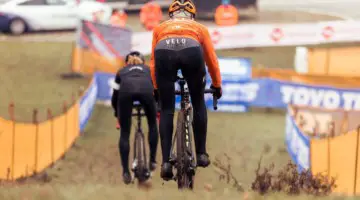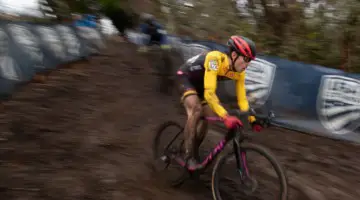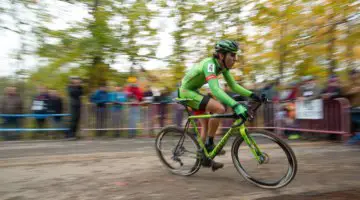This week’s column from Chris Mayhew of JBV Coaching focuses more on technique, philosophy and etiquette rather than training, especially if you enjoy life in the fast lane. Enjoy his latest Technique Tuesday piece below.
I’ve had several requests to write an article about passing etiquette in racing. At first I demurred, for two reasons. First, my opinion differs greatly from at least three people much higher up the food chain than I. Second, my personal dealings with aggressive racing are certainly an area for personal growth. But the more I thought about the issue the more I feel I have enough perspective to at least talk about it. So consider this less of an instructive column and more of an opinion piece. If we were in the car together on a long drive back from a race this would come after the obligatory tubular talk but before we put on a podcast.
So what behavior are we talking about? I’m speaking of any time you pass another rider on course, be they lapped or not, in your field or not. The requests I’ve gotten are to counsel people to not be overly aggressive when passing. What does that mean? I’d consider an overly aggressive pass anything that requires reaction on the part of the rider(s) being passed to avoid a collision. For example, having to grab a handful of brakes or having to make contact with the passing rider or a course marker. I would also include any untoward verbal comments as well. Typically this happens when passing lapped riders or riders not in your field when doing staggered starts, but it can also be just part of normal head to head racing. Already we’re in territory where people will disagree with me, and that’s fine. My comments are mainly directed towards the average weekend racer and what holds there. Muhammad Ali got to behave the way he did because he was the best at what he did. It’s a little less becoming for a weekend warrior to act like he or she owns the course. So that’s my first comment, bring a sense of proportion to things. I know things like this happen but you’re not the World Champion on the last lap of a Superprestige:
(To my eye that’s purely a defensive move on Van Aert’s part anyways.)
So why engage in such behavior? Why be overly aggressive in how you deal with other riders? I think there are several reasons for it. One is that there’s less risk to participants in cyclocross compared to racing on pavement, the consequences of a crash are not so bad in general.
The sport has also gotten very big, with fields up to 120+ riders on courses that really are built to accommodate 40 or 50 riders. Some riders are just using the tools they have. They can corner very well, better than those around them, so the corners seem the obvious place to pass. Or maybe they can start well but can’t maintain that pace, so they’re aggressive for a lap or two before lack of fitness starts to take over. I have certainly experienced people feeling they own the course and refusing to let people by, which I think is largely due to ego. The yelling at lapped riders mainly comes from pressure (you’re probably fighting for a paying spot) and not being able to deal with the heat of the moment.
So, what to do about these situations? The first rule of bike racing is that your front wheel is your responsibility. Behave accordingly. Don’t overlap wheels, don’t put your front wheel in situations where someone else can take it out from under you. But I’ve also raced bikes long enough to know that even doing everything right, especially in ’cross where there are multiples lines through a corner, things can go wrong, there are factors beyond your control. See this example from the Gran Prix of Gloucester many years ago when Jonathan Page was battling teammates Tim Johnson, Jamey Driscoll and Jeremy Powers:
(Turn the sound down if adult language will disturb others at work. I’ll also note, you can clearly hear Powers tell his teammates to wait for Page…class act!)
The real point of this column is that this sort of behavior is your responsibility to deal with. People who yell at Juniors or take the hot line through a corner probably aren’t going to read this column and suddenly change their ways. The best advice my boss John Verheul has ever given me is “there will always be one.” Recognize that someone always has and always will pull a move that you think is dumb. Because of this, it’s on you to manage your reaction to that behavior and not demand immediate resolution of the issue by expecting someone else to change. You’re not going to be very happy with the outcome if that’s your expectation.
Speaking of expectations, realize that if you’re starting a race beyond the first three of four rows, some contact and chaos is simply the nature of the beast. When you experience stuff like this in the sixth row of a 3/4 race, know that’s just how it is:
When stuff like this happens, you might as well get mad at water for making you wet. Pick yourself up and carry on as best you can, and maybe even have a laugh. Again, let me emphasize, changing your mindset is the most valuable thing you can do. Don’t get angry, or blame others. Deal with things as they are, solve the problem at hand, and move on.
What are some practical ways to solve this problem? The biggest issue I see is people trying to take the corner with a line that gives good entry speed but poor exit speed. Typically you can avoid the crowds by taking a broader line that allows you to avoid riding wheel to wheel with everyone else. Notice everyone on the inside of the corner while Hyde takes the faster outside line, almost alone:
The next thing you can do is pick your battles wisely. In the first few laps of a race it is rarely worth fighting for a wheel. Don’t get put in a bad position, but if someone really wants to be somewhere, let them slot in. It can often turn out poorly for one party and sometimes both.
Also, if you are making a pass like this or defending against a pass like this by blocking the line, always leave the other rider a choice or a way out. In this example, and the one with Tim Johnson, I would argue the other rider was left with no choice in what to do. But you can pass or block a rider in such a way that it leaves them the choice of continuing on their present choice of action and risking a crash or relenting and allowing safe passage for both of you. I watched Hyde and Powers swap positions six times in six corners in the last half lap of the Pan Am championship in Cincinnati last year. Neither of them made contact with the other but they did make a firm assertion of who was in the lead with each pass, while not interfering with the other rider. [Mathieu van der Poel and Wout van Aert also swapped leads countless times at last Sunday’s Superprestige Zonhoven without incident, as seen here -Ed.]
“Don’t get angry, or blame others. Deal with things as they are, solve the problem at hand, and move on.”
Lastly I would add I think the rules loosen up a bit in the last lap for paying spots. Doing what needs to be done to win your individual battle without just turning sideways into another rider is fair game (although don’t go this far). Keep your hands on the bar (always), but take the line you need to take and understand the other rider will be as well. A good rule to remember then is whoever is in front gets to dictate line choice, anyone following has to react accordingly. But if you’re beyond a paid spot I’d urge you to have a sense of proportion and weigh the kind of behavior you’re engaging in against the stakes involved. Do you really want to put a rider into a tree for 25th spot? I realize this is important to you but also realize there will always be next week, and there is life beyond the tape. And that if your only means of maintaining that spot is a move like that, perhaps it’s not as deservedly yours as you think.
And what if you are a rider who is good at cornering, or at least better than the riders around you? Get in a good position before the corners and then use your superior skills to attack through them. Or at least use your skills to exit the corner faster and gap the others. Entry speed into a corner is almost never a deciding factor in winning a corner. Your ability to exit with the most speed is what ultimately wins the corner, and makes for a much cleaner pass. Or use your cornering ability to rest in the corners and attack a straightaway near the finish with the energy you saved. We are still in a pedal bike race, ultimately, even if there is a premium on handling skills in this particular discipline.
“Entry speed into a corner is almost never a deciding factor in winning a corner. Your ability to exit with the most speed is what ultimately wins the corner, and makes for a much cleaner pass.”
What about situations where you’re passing a lapped rider? To the lapped rider I’d say remove your ego from the situation. It’s not a sign that you’ve failed or done something wrong. It’s something that has happened to everyone who has ever raced, and let it be motivation to do the work so that it doesn’t happen next week. As soon as you reasonably can, signal which way you are going to move and go to a side of the course that allows the other riders to pass. Or cede the best line through a corner to the lead riders and let them go. The quicker the action can take place the less time there is for egos to get involved in the matter, which then leads to aggression.
For the riders doing the lapping nothing more than a firm but polite “lead riders” is needed. It’s in your interest for this to go smoothly. When officials get complaints about lapped riders they are more prone to pull them. With the 80% UCI rule and its American interpretation that can happen very quickly these days. Pass as quickly as possible, with as much room as possible. As in life, a quick “thank you” goes a long way too. What you both want to avoid is this sort of situation, also seen below:
We’ve all had our experiences with unpleasant passes in a bike race. It happens for a wide variety of reasons. But almost none of those reasons are under our control. The most effective way to deal with aggressiveness in bike racing is to control our own reactions to the behavior and not let it throw us off our game. Do your best to defend against it where you can, and don’t overreact when you can’t do anything about it.
Have your best cyclocross season ever with all of our Training and Technique Tuesday pieces here from coaches Mayhew, Adam Myerson and Kenneth Lundgren and others. Can’t get enough? See our Cyclocross Academy and Cyclocross 101 articles here.




























